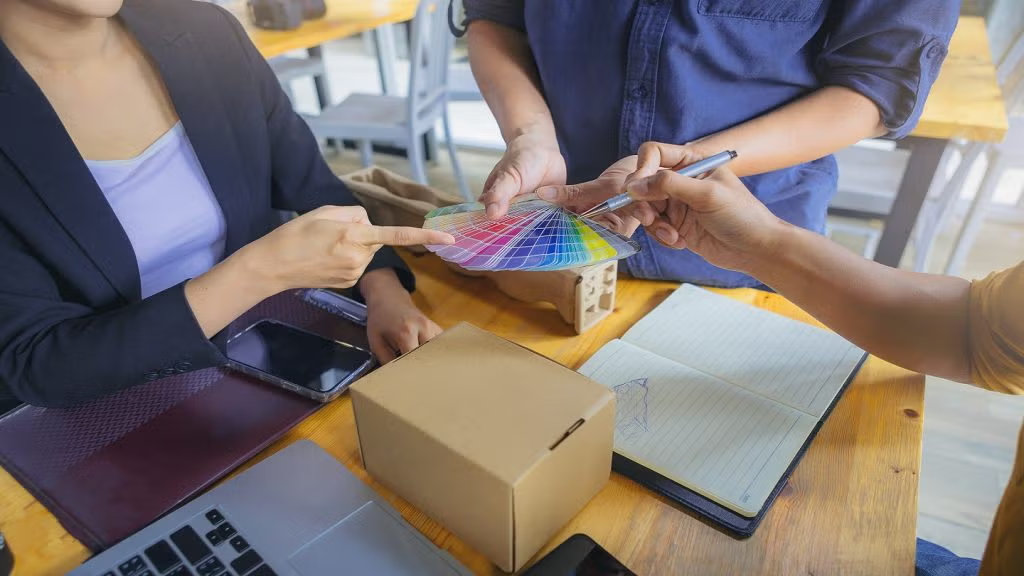Standing out on the market shelf in the fast-paced consumer market is paramount to brand success. Box packaging mockups are a critical tool used by packaging consultants to help brands achieve this. A realistic box packaging mockup gives businesses a tangible preview of their product’s final presentation, enabling them to make informed decisions early in the packaging design process. This blog post explores how packaging consultants utilize box packaging visuals to drive innovation, optimize costs, and ultimately, ensure market success.
The Power of Visualization: Why Box Packaging Mockups Matter
Before a product ever hits store shelves, countless decisions are made about its packaging. Color palettes, material choices, structural design, and branding all play a role in influencing consumer behavior. However, it’s difficult to fully grasp the impact of these elements in isolation. That’s where box packaging mockups come in.
- Early Error Detection: Mockups provide a visual representation of potential design flaws or structural weaknesses before expensive production runs.
- Enhanced Communication: They serve as a common language between designers, manufacturers, and brand stakeholders, minimizing misunderstandings and ensuring alignment.
- Consumer Feedback: Mockups allow for real-world testing and gathering valuable feedback from target audiences, leading to data-driven improvements.
The Consultant’s Toolkit: Tools and Techniques for Creating Effective Box Packaging Visuals
Packaging consultants have access to a range of tools and techniques for creating effective box packaging mockups. Here are some common approaches:
- Physical Mockups: These are tangible prototypes constructed from cardboard, paperboard, or other relevant materials. Physical mockups offer a realistic representation of the box’s size, shape, and structure.
- 2D Digital Mockups: Created using graphic design software like Adobe Photoshop or Illustrator, 2D mockups allow for quick iterations of color schemes, branding elements, and text layouts.
- 3D Packaging Mockup: Taking visualization a step further, 3D mockups provide a photorealistic representation of the packaging. They can be rotated, viewed from different angles, and even placed in simulated retail environments. “3D Packaging Mockup” can accurately illustrate texture, light, and shadow, providing a more immersive experience.
- Packaging Mockup Software: Specialized software allows users to create dynamic and interactive mockups, often with features for simulating folding, assembly, and even transit conditions.
The Packaging Design Process: Integrating Mockups for Optimal Results
Mockups are most effective when integrated strategically into the packaging design process. Here’s how consultants typically incorporate them:
- Conceptualization: Initial mockups are used to explore different design directions and gather initial feedback. These can be rough prototypes or simple 2D visuals.
- Refinement: Based on initial feedback, the design is refined, and more detailed mockups are created. This stage may involve experimenting with different materials and structural designs.
- Validation: Final mockups are used to validate the design with target audiences and stakeholders. This may involve focus groups, surveys, or in-store testing.
- Production: Once the design is validated, the final mockup serves as a blueprint for production. It ensures that the finished product meets the desired specifications.
Unlocking Value: The Tangible Benefits of Using Box Packaging Mockups
Investing in box packaging mockups may seem like an added expense, but the benefits far outweigh the costs.
- Reduced Costs: By identifying and correcting design flaws early, mockups prevent costly production errors and rework.
- Faster Time to Market: Streamlining the design process through clear communication and efficient iteration shortens the time it takes to get a product to market.
- Improved Product Visibility: Well-designed packaging that resonates with consumers increases product visibility on the shelf and drives sales.
- Strengthened Brand Image: High-quality packaging reinforces brand values and enhances the overall customer experience. One of the “Benefits of Packaging Mockups” is elevating brand perception.
Custom Box Printing: Considerations for Mockups
When creating box packaging mockups, it’s crucial to consider the custom box printing process. Factors like ink coverage, printing techniques (e.g., flexography, offset, digital), and substrate materials can significantly impact the final appearance of the packaging. Consult with printing experts early in the design process to ensure that the mockup accurately reflects the capabilities and limitations of the chosen printing method.
Sustainability and the Role of Mockups
In today’s environmentally conscious market, sustainability is a key consideration for packaging design. Box packaging mockups can be used to assess the environmental impact of different material choices and structural designs. Consultants can leverage mockups to explore options for reducing material usage, incorporating recycled content, and designing for recyclability or compostability.
Conclusion
Box packaging mockups are an indispensable tool for packaging consultants. They provide a tangible representation of design concepts, facilitate communication, and enable data-driven decision-making. By integrating mockups strategically into the packaging design process, consultants can help brands reduce costs, accelerate time to market, improve product visibility, and strengthen brand image. For businesses seeking a competitive edge, investing in high-quality box packaging mockups is a smart choice. Partnering with experienced packaging consultants like Acumen Packaging allows your business to get expert help with the packaging process. Acumen Packaging has over 24 years of expertise that you can use to provide flexible and cost-effective packaging solutions for your business, contact us to subscribe to our newsletter and learn more about how we can help you achieve your packaging goals!





